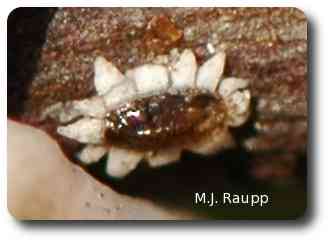This many wax scales make up an un-jolly holly.
While on the way to my local grocery store last week, I passed a landscape bed heavily planted with roses and inkberries which plant aficionados recognize as a species of holly. Branches of several plants were festooned with small white globs of what appeared to be wax. These were insidious invaders, wax scales, are regular perennial pests of many trees and shrubs found in southern states where temperatures suite their life style.
Beneath the white wax is the small reddish scale insect.
In recent years with warmer winters further north, we have seen many southern pests creep into higher latitudes. Although it is not unusual to find wax scales as occasional visitors in Maryland’s landscapes, they have become regular guests in our region and it is no longer unusual to see hollies and many other landscape plants including roses, boxwoods, firethorns, spirea, and quinces heavily infested. Hence, wax scales are waxing indeed. Wax on! The large wax scales were adults that endured the chilly winter on the bark of the tree. In a few weeks with the return of spring’s warmth and the flow of sap in shrubs and trees, these largely sessile creatures will resume feeding and begin to lay as many as a thousand eggs by June.
For obvious reasons young scales are called cameos.
In the wild, males of this species have not been observed. The females have found a way to bypass the romance and get straight to the business of laying eggs. This interesting reproductive strategy called parthenogenesis is fairly common in insects. Eggs hatch and tiny mobile crawlers move along branches and find new places to hunker down, insert their long sucking mouthparts into the bark of the tree, and imbibe nutritious sap. They soon produce a small ring of wax around their bodies. Their resemblance to Victorian jewelry has earned them the name cameos. To acquire sufficient nutrients from the sap requires a great deal of sucking and excess food is eliminated in the form of sweet, sticky, liquid called honeydew. We met other honeydew producers like aphids and tulip tree scales in previous episodes of Bug of the Week.
The honeydew accumulates on bark and leaves and serves as a substrate for the growth of fungus called sooty mold. Sooty mold does not harm the holly directly, that is, it causes no disease. However, some people find the grimy substance disagreeable and one can imagine that enough sooty mold might cut down on the plant’s ability to gather energy from sunlight. For bug geeks, sooty mold is a sure sign of the presence of a potentially glorious insect and a signal to intensify the search. When abundant, wax scales can really set your plants back. If you find wax scales on your shrubs or trees, and deem them problematic, one easy solution is to simply pluck them off the plant and toss them to the ground. Wax off! On the soil they will be consumed by a ravenous horde of ground dwelling meat-eaters. Destruction of wax scales is easily accomplished during the holiday season when adults are large and apparent. In spring after thousands of eggs hatch, the task of destroying scales is more complicated and the use of systemic insecticides may be warranted. So, for the next several weeks wax scales are yours for the picking.
References:
Managing Insect and Mites Pests on Woody Plants by John Davidson and Michael Raupp was used to prepare this episode. To learn more about wax scales please visit the following website: https://content.ces.ncsu.edu/insect-and-related-pests-of-flowers-and-foliage-plants/scale-insects-in-the-greenhouse



